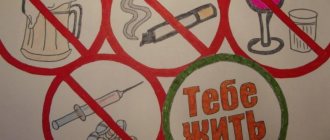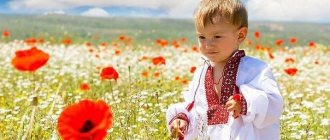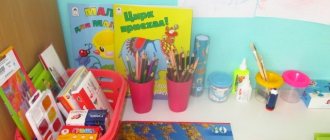A preschool educational institution is an organization where primary public education of children is carried out, the first link of public education in most developed countries. Toddlers and older preschoolers are in kindergarten from about seven in the morning until five or seven in the evening, learning the minimum necessary communication skills, playing, and preparing for school. To prevent separation from parents for the whole day from being too traumatic for the baby, conditions similar to those at home are created in the preschool educational institution - an abundance of toys, friendly teachers, and the opportunity to sleep during the day. An important factor is the design of the kindergarten - beautiful, comfortable premises, safe areas.
Design principles
When choosing a kindergarten, the first thing parents pay attention to is the interior. This is the calling card of the institution; it is designed harmoniously, in a memorable manner. Children should feel comfortable in it so that they want to return there every day.
The basic principles of the improvement project are approximately the following:
- compliance with the name - the “Bee” kindergarten should have in its design figurines of bees, black and yellow elements, and the “Fairy Tale” kindergarten should have images of heroes of famous fairy tales;
- the walls of corridors and lobbies are painted with various scenes so that children find it interesting to look at them;
- clear zoning - each group must have a separate locker room, bedroom, games room, in harmony with each other;
- the interior for children of different ages is decorated with different pictures - for the younger group, the plots of “Ryaba Hen”, the cartoon “Little Kids” are suitable, for older ones - fairy tales about “The Sleeping Beauty”, “Ivan the Tsarevich”, etc.;
- The design materials chosen are environmentally friendly, predominantly natural.
Materials, finishing methods
Basic, most commonly used materials:
- tree;
- Fiberboard;
- MDF;
- plastic;
- drywall;
- ceramic tile;
- dye;
- wallpaper.
All materials must be harmless to children’s health and have radiation safety certificates. Ceilings are most often whitewashed and painted with water-based paint. The walls are made smooth so that they are easy to clean, and the floors are not slippery. The walls, floors of sanitary premises, catering units are decorated with tiles, oil paint, and decorative plaster. The floors in the groups are made of wood, laminated, natural linoleum, without cracks or protruding parts. In cold regions, heated floors are preferred. In groups, rugs and rugs are laid on the floor.
The furniture is also selected to be environmentally friendly, comfortable, and light. Preferably one that “grows with the child” - adjustable in height. It can be hard or soft.
paper horse
In the photo of the crafts in the preparatory group you can see an interesting product - a horse made from a paper template.
To work, you will need brown double-sided cardboard, a black felt-tip pen, double-sided black paper, and the presence of scissors, pencil glue and a simple pencil are also important for the work.
In addition, find a horse template on the Internet that you will use for your work.
Color palette
Rooms with windows facing north are painted in warm colors - beige, light yellow, orange-pink, peach. “Southern” rooms are decorated in cold colors – light blue, pale green, soft violet. Up to 25% of the area can be painted more brightly, but use a minimal amount of aggressive colors.
With the help of color, rooms are zoned - individual places are highlighted with bright colors and pictures.
How do different colors affect children?
- pink – calms, the child feels safe;
- blue – promotes concentration and relaxation;
- blue – gives calmness, relieves internal tension;
- yellow – helps to communicate, learn new skills;
- red – gives self-confidence, in large quantities increases anxiety;
- green – improves brain function, too bright can tire you.
Crafts for March 8
Tulips are very delicate and graceful flowers. And such crafts for March 8, made in the preparatory group, will be an ideal gift for mothers.
These flowers can be put in a bouquet or given one at a time - in any case they will look very beautiful. Materials to prepare:
- Disposable plastic spoons,
- One flower will require four pieces,
- Scotch tape and colored corrugated paper,
- Shades should be green and red.
For one flower you need up to one meter of each type of paper. Wrap red paper around the spoons, and wrap the handle of the spoon in green paper and use tape to secure it. Attach leaves cut from green paper.
Beautiful flowers are ready, you can arrange them as a bouquet in a basket.
Design of individual rooms or zoning
Zoning of space occurs by dividing it into functional zones with defining boundaries.
What are the boundaries?
- volumetric - partitions, screens, walls, furniture, curtains;
- spatial – these are different floor heights in different zones, colors, lighting, architectural elements;
- combined - the space is simultaneously divided and connected, these are stained glass windows, grilles, curtains, columns, arches;
- translucent, completely transparent - this is how physical separation is achieved while maintaining a visual connection.
Flexible zoning is preferred - prefabricated cabinet structures, sliding partitions, screens, transparent screens. Children often take a direct part in zoning, together with their teachers. Platform podiums with fences and various partitions are often used - straight, angular, curly, of various heights, widths, lengths. The decorative design of the ceiling on holidays will also become an element of division into zones - these are flags, balloons, paper garlands.
Senior groups are often located on the second floor, so the safety and aesthetic appearance of the stairs should also be taken care of. The walls along them should be beautifully decorated - for example, there should be an exhibition of graphic and painting works by students.
Play and study room
Most often, children play and eat in the same rooms. Furniture is selected according to the height of the children - in the younger and older groups it will vary greatly in height.
Posted here:
- tables, chairs;
- racks for books, toys;
- paints, felt-tip pens;
- finished works made by children's hands;
- musical instruments.
The walls are decorated with bright, non-aggressive wallpaper and drawings - developing stories, episodes from fairy tales and cartoons are welcome. In the play area, a soft, warm carpet is laid on the floor. Cabinets, racks for toys, books are selected with minimal risk of injury, are stable, and are well secured. The study area should be sufficiently well lit, visually separated from the play area by a different floor covering, walls, or with the help of partitions. Here children learn to read, write, draw, and sculpt. Zones of various games are separated from each other by decorative houses and screens - a kitchen with a toy set, a railway, a Lego town.
Dining area
The dining room is separated from the playing area by a screen and shelving. For ease of cleaning, do not place a carpet in this place, because children often drop food on the floor, spill it, and scatter it. The furniture here includes tables designed for two to four people, and chairs suitable for the height of the bench. On the wall there is a menu, an explanatory note, which describes and depicts how to properly use a spoon, fork, and napkins. The tables are covered with tablecloths and colorful oilcloths. Cartoon characters are often depicted on the walls eating.
Locker room
This is one of the first rooms where children and their parents find themselves when they come from the street. It is decorated brightly, a variety of subjects are used, wallpaper with images of animals and fairy-tale characters is used. Stands with important information, announcements, schedules, and height meters are placed on the walls. They draw on clothes lockers, stick different letters and pictures on them so that each child can easily remember his own and find where his things are. Long benches are placed in the center of the locker room so that the students can dress comfortably, and a carpet is laid on the floor.
Bedroom
The bedroom is intended for daytime sleep, night rest in the gardens with 24-hour stay. It is decorated in calm, mostly pastel, tones. Thick curtains are hung on the windows - the room should be darkened during the daytime rest. They are selected from natural, eco-friendly materials that suit the style. The structures to which they are attached must be highly reliable, and the fabrics must be practical and durable. You can simply whitewash the ceiling or depict a starry sky on it.
What should a bathroom be like?
Strict requirements are imposed on kindergarten bathrooms. Ceramic tiles are laid on the floor, which are easy to clean; on the walls, such covering should be at least one and a half meters high. In the younger groups, the toilet is equipped with pots, in the middle and older groups - with toilets, washbasins, and mirrors. The older the children, the more spacious this room should be. For older children, toilets are located in stalls, but the doors should not have locks. Each student has his own towel, which he hangs on a hook in a separate compartment. In the showers, drainage is provided through holes in the floor; for safety, rubber mats and wooden pallets are used.
The importance of a developing subject-spatial environment in the senior group of preschool educational institutions
The task of any preschool educational institution (DOU) is to create conditions for the development and upbringing of children, maintaining their health in a safe and comfortable environment. The most important component of this task is the organization of a subject-spatial environment that corresponds to the components of the educational and developmental process carried out by teachers. It has long been proven that a child’s development occurs with his active participation in a variety of activities. For senior group students, the following areas are highlighted:
- training and development activities;
- performing practical and creative work;
- role-playing games;
- basics of labor activity;
- physical education classes;
- music and choreography lessons.
The administration of a children's educational institution, teachers and educators must create a multi-component educational environment for a preschooler, which takes into account different aspects of organizing the process of raising and developing a child. This:
- developing subject-spatial environment;
- organizing interaction with teachers;
- communication with peers;
- the preschooler's attitude to the world around him and to himself.
Children should live in a world of beauty, games, fairy tales, music, drawing, fantasy, and creativity.
V. A. Sukhomlinsky
Principles of constructing a subject-development environment
The subject-spatial environment in the older group serves the development of children's activities, primarily play. Indeed, during play, the leading activity of preschool children, cognitive motivation develops, which is the basis of educational activity. The subject-spatial developmental environment must correspond to the zone of proximal mental development of a 5-6 year old child - the formation of prerequisites for educational activity.
Decoration of children's playgrounds
There are two main zones on the territory of the kindergarten:
- recreational - where students walk and play;
- economic - special transport arrives there and performs loading and unloading.
Experts recommend making playgrounds different - for children of different ages, their communication, games, and any events. The presence of natural areas is complemented by play elements made from natural materials. Also, convenient access to the territory of the preschool educational institution is provided, and the presence of short-term rest areas for adults who look after children is encouraged. Various techniques of modern landscape design are used.
On the site there are:
- sandboxes;
- swing;
- horizontal bars;
- stairs;
- sun canopies;
- tables, chairs, benches;
- equipped places for sports games;
- houses, gazebos;
- plot sculptural compositions.
Some of the decor is easy to make with your own hands - animals from car tires, ladders from wooden slices, logs, miniature buildings from plywood, flower beds, alpine slides. Trees are made from colored plastic bottles, flower bed fences are made, paths are lined with pebbles painted to look like ladybugs and beetles. All decorative elements are painted with bright colors, and the walls of the kindergarten building are decorated with fairy-tale scenes.
Often the garden building has a gym or a swimming pool - children need to develop physically. The gym is equipped with a wall bars, balls, trampolines, basketball hoops, hoops, and skittles. The swimming pool must comply with safety standards, be equipped with life buoys, and be of shallow depth.
Creating a living corner
A living corner is a developmental area that teaches children the first skills of caring for animals and plants, allowing them to observe their behavior and development.
People most often living here are:
- hamsters;
- rabbits;
- Guinea pigs;
- decorative mice, rats;
- parrots, canaries;
- turtles, lizards;
- certain types of aquarium fish.
Various indoor plants in pots are often placed here - it is important to choose exclusively non-poisonous ones that cannot cause allergies or injure curious children with thorns or thorns. Children give animals food, clean cages under the supervision of adults, water flowers from watering cans, learning about the world of flora and fauna. All necessary equipment is stored here - children learn to use it.
All about decor and choice of textiles
Textiles are selected to match the overall color scheme. All fabrics are preferred natural, environmentally friendly, fireproof. Dust should not accumulate on them; bedding fabrics must not contain components that can cause allergies. High-quality textiles will not have to be changed after one or two years; they will not fade in the sun or lose their appearance. Pupils, together with adults, make crafts from fabrics, paintings, appliqués from felt on a linen base, sewn toys to decorate the head’s office. Themes and plots used are different.
Rag wall organizers for stationery and interior dolls will also decorate the interior of the room. In the bedroom there are decorative panels depicting sleeping animals, in the dining area there are textile paintings where cartoon characters eat and prepare food. Several textile tents are placed in the games room, in which some children can hide and retire if necessary.
Fabric pockets for a children's locker are easy to make yourself. To do this, you will need about a meter of fabric, from which two pieces 30 by 80 cm are cut, two pockets 40 by 20 cm and 40 by 15 cm. An elastic band is sewn into the upper parts of the pockets, on which they are slightly pulled together, sewn to the base one after the other, starting from the bottom. Afterwards the second part of the base is attached, a strip of plastic is inserted at the top and bottom for rigidity. The edges are decorated with bias tape and strips of the same fabric. Loops are sewn into the upper part on which the pockets will hang. They store spare panties, socks, gloves, a hat, a comb, and office supplies. If desired, the design is decorated with embroidery, applique, and beads.
About facing materials and equipment
The walls of the kindergarten should not be covered with wallpaper. All surfaces must be thoroughly cleaned and washed. In the games area, you can plan a wall painting that will depict cartoon characters or funny animals .
It is recommended to cover the drawings with wax; this will protect them from mechanical damage; in addition, such a surface is easy to clean. A cheaper option is to decorate the walls with appliqués.
Plastic panels are quite suitable for the bedroom. The design of walls in a kindergarten can be done with decorative plaster, which has a weak texture. The study area can be painted in bright colors, with decorative accents.
The floor covering should be as safe and tactile as possible. This could be a light-colored laminate flooring covered with medium-pile carpeting.
All furniture in the kindergarten should be adapted to the growth and needs of the children. In addition, its objects should be bright and interesting, attracting attention. It is best if it is made of natural wood.
If the beds in the bedroom are bunk, the second tier must be equipped with a side. In addition, the area must be equipped with lockers for storing clothes.
Play areas are equipped in different ways; the best option is to use soft ottomans, as well as racks and shelves with toys.
In the study part of the groups, as a rule, there are open cabinets for books, notebooks and other study supplies, small desks with chairs. Do not forget to provide a workplace for the teacher.
Textiles play an important role in the design of a kindergarten; it gives the premises a homely look. Use light and bright curtains, complement them with napkins, tablecloths, and towels that add comfort.
Indoor decor elements need to be safe and unbreakable. Toys are perfect for this, but they should not be placed in the learning part of the groups, otherwise the children will be distracted all the time.
Living plants, which are placed in flowerpots at a height where children cannot reach them, will help decorate the design of the kindergarten premises.







